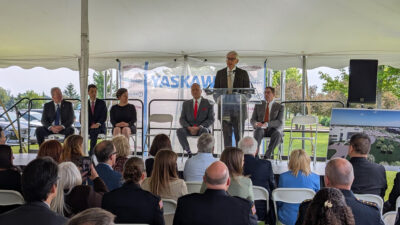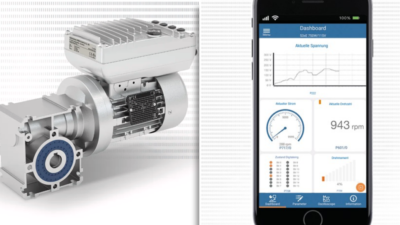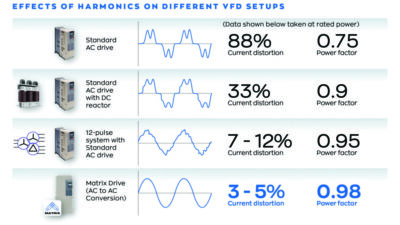Just as thermal imaging is becoming white hot for predictive equipment maintenance, industrial engineers are becoming increasingly aware that it makes an excellent primary sensor to keep control systems on track. Thermal imaging, or thermography, maps the surface temperature of an object by means of the infrared (IR) radiation it emits.
Sidebars: Thermography vs. IR imaging technology Measuring more than temperature
Just as thermal imaging is becoming white hot for predictive equipment maintenance, industrial engineers are becoming increasingly aware that it makes an excellent primary sensor to keep control systems on track.
Thermal imaging, or thermography, maps the surface temperature of an object by means of the infrared (IR) radiation it emits. A thermographic scanner codes different temperatures as different colors, making it possible to visualize very narrow temperature ranges. All thermal imagers use “false colors” to display these images, since the true colors are all infrared, and therefore invisible to the human eye. More importantly, the equipment is also capable of analyzing the images to extract precise control information.
Thermography growth trends
Historically, thermal imaging has grown by insinuating itself into new application areas, consolidating its acceptance into each role, then expanding into other application areas. Perhaps its earliest industrial use was for failure analysis of electronic assemblies and components during the 1980s. Engineers analyzed thermal images of printed wiring boards that had failed electrical testing. By analyzing failures, they hoped to modify designs or manufacturing processes to improve yields.
Some designers also used thermal imaging to analyze heat-flow in prototype boards. In the absence of, and later to augment, computerized heat-flow simulations, thermal imaging provided the fastest and ultimately least expensive tool for controlling heat in electronic assemblies.
By the late 1990s, facilities engineers began developing predictive maintenance programs incorporating regular thermography surveys. They periodically collected thermographs of select equipment, such as electric motors, switching gear, transformers and other power-handling devices. Incipient failure mechanisms, such as bearing wear, insulation breakdown and contact corrosion created anomalous hot and cold spots that grew over time, as shown in the Flir thermographic image of motors (page 38). Spotting such trends early allowed problem correction before catastrophic failure..
We are now at the stage where process engineers are starting to use thermography to help control manufacturing processes. Armed with detailed knowledge of how critical temperatures vary in time and space, engineers can adjust automated-control setpoints and parameters to improve quality and maximize yield.
Plastic packaging film, for example, is produced in a continuous web extrusion process. Polymer material enters the extrusion machine as a liquid heated to above its melting point, where it has viscosity between that of molasses and water. The hotter the material, the lower its viscosity.
Several pipes feed the material, which extrudes through a die as a wide sheet at 120 to 140 feet per minute. The web is under tension, which pulls and stretches the sheet, so material accelerates to 1,000 to 2,000 feet per minute as it passes to a cooling roller called a nip. There it cools and solidifies, stabilizing its dimensions.
The material’s viscosity, of course, affects how much it stretches under a given load tension. Warmer, less viscous material will stretch farther and grow thinner than cooler, more viscous material.
The sheet, up to 400-in. wide and a fraction of an inch high, consists of several zones across the web, with material in each zone coming from a different pipe. The final sheet’s uniformity depends critically on the uniformity of melt temperature in the pipes. A pipe whose temperature is too low will result in an overly viscous zone that doesn’t stretch enough, and it will carry internal stress that can tear the web.
The primary process controls are, therefore, the temperatures of the polymer melt flowing through the pipes. In a sophisticated system, heaters can control the melt temperature in a closed loop fashion. Since melt material flows through the pipes rapidly, there can be a significant temperature difference between the pipe-wall temperature and the temperature of material flowing inside.
It is important to control the material temperature, rather than the pipe temperature, so control system engineers insert thermocouples built into thin probes through the pipe walls into the moving flow. Even then, the material temperature can vary over time as the control system seeks to hold it at the setpoint. To account for temperature differences across the width, pipes are controlled individually, so setpoints can vary from pipe-to-pipe (zone to zone) across the web.
Another problem arises from the fact that melt material loses heat while traveling from pipe to die and then from die to nip. It’s the temperature in the region from die to nip, where all the stretching occurs, that is most critical. Of course, the heat-loss rate varies across the web, being lowest in the center and higher at the edges. Without closed-loop control, the edges become cool and viscous while the center stays hot and watery.
Visualizing temperature
Andy Christie of Optex Process Solutions helps film manufacturers deal with these issues to keep web processes optimized and under control. He uses a thermograph to monitor variations across the web in the all-important zone just after the melt exits the die.
The Raytek EC100 line-scan thermograph, has a field of view of one scan-line high. Vertical scanning arises from the web passing over the field of view. Thus, approximately 30 times per second, the thermograph measures temperatures along a line across the web-movement direction. Web speed divided by scan rate determines location of the next, parallel line of temperature measurements.
Individual scan lines captured by the imager go directly to a laptop computer, which displays a horizontal line on the screen. Colors at different points on the line represent temperatures at corresponding points on the web. The operator can adjust the width of the temperature range to be displayed to match the range of temperatures of interest.
“Maybe their target temperature is 610 °F,” Christie says, “and the temperature may vary from 595 to 620 °F. I [would] show the low temperature 595 as a blue color and 620 as a yellow color and a spectrum of colors in between.”
Temperatures above and below that would show as solid white or black respectively. If, on the other hand, the range were 100-1,000 °F, Christie would expand the scale to cover that range.
As the next scan comes into the computer, earlier lines shift up to make room at the bottom of the screen to display it. As time goes on, the system builds up a false-color map with horizontal position corresponding to position across the web, and vertical position corresponding to position along the travel direction.
If, for example, the heater control loop for one pipe begins to oscillate, the color of the vertical band corresponding to that zone would show periodic color shifts. Similarly, if one pipe consistently runs hotter, the image will show a vertical stripe of a color corresponding to a hotter temperature.
The system allows process engineers to adjust setpoints for loops controlling individual pipes’ temperatures. For example, when observing edges running cooler than the middle because of excessive heat loss, an engineer can turn up the setpoints for pipes feeding the edges, making the web temperature more uniform.
“You can also open up multiple windows,” Christie says. “I’ll frequently open a second window to show a graphical display of the last scan” (as the Optex thermograph of the web shows on page 35).
The graphical display uses the quantitative data underlying the qualitative false-color image, making thermography far more useful than the simple qualitative pictures from IR cameras. Instead of just saying “that zone is hotter,” which may be useful for maintenance programs but not much good for control applications, thermography gives actual measurements.
Tempering glass
Web processes are not the only ones where thermograph data can be used to control manufacturing process. Tempering glass, for example, requires bringing an entire glass sheet up to a uniform temperature above its softening point, then quenching it rapidly enough to introduce just the right amount of internal strain. This strain creates glass 4 to 5 times stronger than ordinary glass, which shatters into tiny glass cubes instead of large, sharp shards.
Ordinary glass can be likened to an extremely viscous liquid. It is so viscous that its flow rate under typical forces is imperceptible. As the temperature goes up, however, the glass viscosity goes down. At annealing temperature (550-650 °F) glass holds its shape well if supported, but the atoms are able to move around to relax any internal strains.
“After [the glass sheet is] heated in the furnace, it goes into the air quench,” explains Clifford Matukonis, process engineer at Tamglass Tempering. For best temperature control, he moves the glass from the furnace to the quench on a conveyor moving at 1,000-1,500 inches per minute. The scanner, same model as in the web application, looks down onto the glass sheet with the scan line perpendicular to the conveyor motion and scans parallel stripes across the sheet.
The air quench is a flat plate perforated by holes through which cool air blows onto the sheet. That cool air rapidly “freezes” the glass, locking in a uniform strain field that depends on the annealing temperature and quenching rate. This uniform strain field gives tempered glass its useful properties.
“We typically put the scanner between the furnace and air quench. At that point, we find out what’s the temperature gradient of the entire sheet of glass,” says Matukonis.
Tamglass controls its process through a number of radiant heating elements mounted over a conveyor belt in the furnace, as the photo shows. Each heating element has a proportional controller using a thermocouple as sensor. Overall process control is via a PC-based system communicating with the proportional controllers over Profibus.
Heating element setpoints vary from about 600-700 °C. Modifying the relative temperatures of heating elements can adjust the sheet’s temperature uniformity, while the amount of time it spends in the oven (controlled by the oven conveyor speed) controls the ultimate temperature. Slowing the conveyor leaves the plate in the oven longer, so the glass reaches a higher ultimate temperature.
As with Christie’s extruded-film application, thermography allows Matukonis to monitor the actual product temperature at the point where it counts most: between the furnace and air quench. At present, only thermography can capture spatially resolved temperature data in the time available. And, as with the web application, gaining insight into both ultimate sheet temperature and temperature gradient enables Matukonis to adjust heater setpoints to tune the control system on the fly.
From supporting actor to star
Now that control engineers are seeing thermography’s ability to help optimize control-loop setpoints, the next step surely will be to take the human out of the loop. They will develop algorithms to tune the process controls automatically, adding a new level of control to make automated manufacturing systems more robust.
In industries now experimenting with thermography as a primary sensor for quantitative information to help engineers tune process controls, future systems will have thermographs backed up by programmable automation controllers (PACs) that calculate appropriate setpoints for PID control loops for individual process controls. While these thermographs will be collecting spatially and temporally resolved temperature data, the PACs will analyze that data to more directly measure process parameters, such as gradients, fill levels, and control-system stability. Such systems will optimize the entire manufacturing process for maximum quality and yield.
For related information visit www.controleng.com and search on thermal imaging.
www.flir.com
www.optexprocessolutions.com
www.raytek.com
www.tamglass.com
Thermography vs. IR imaging technology
Thermography and infrared (IR) imaging are two quite different methods for forming images using the infrared thermal radiation emitted by objects at ordinary temperatures. The primary difference is the sensing element used to develop an electrical output from electromagnetic radiation.
Every object emits electromagnetic radiation by virtue of its having a non-zero temperature. Spectral intensity (intensity as a function of frequency or wavelength) takes on a characteristic shape, being zero at zero frequency, increasing rapidly to a peak, then asymptotically re-approaching zero at infinite frequency. The position of this intensity peak moves to higher frequencies (shorter wavelengths) as the object’s temperature increases.
The peak appears at radio and microwave frequencies for objects at cryogenic temperatures (tens of Kelvins); infrared frequencies for objects at typical temperatures (a few hundred Kelvins)’ and in visible light for vigorously heated objects (thousands of Kelvins and above).
IR imagers use area-scan technology to collect radiation from all parts of the image simultaneously, while thermal imagers use a moving mirror to form images a pixel at a time. In progressive-scan systems, source movement provides vertical resolution. Source: Control Engineering
Note that the peak thermal-radiation frequency increases smoothly with increasing temperature, from infrared through yellow and blue, then finally to ultraviolet and beyond. Humans associate blue with coolness and red with heat because of an evolutionary accident: the coolest objects our ancestors encountered were water and ice, which appeared blue by virtue of reflecting the blue of the sky; the hottest objects they encountered were open fires, which glowed red or yellow. Astronomers, who encounter objects (stars) whose temperatures vary from a few thousand to millions of Kelvins associate red with cool and blue with hot.
The infrared wavelengths that thermal imagers and IR imagers sense are invisible to human eyes, so the equipment assigns different colors of visible light to specific wavelengths, producing what are called “false color images.”
As the drawing shows, an IR imager is essentially an area-scan charge-coupled device (CCD) camera with an infrared filter in front of it. Silicon CCD elements have significant response in the infrared as well as the visible parts of the spectrum. CCD cameras intended for visible wavelengths, in fact, must filter out infrared light to produce acceptable pictures.
CCD elements respond to light by converting the energy of incoming photons to free charge carriers. Each photon absorbed, therefore, directly produces a certain number of free charges, which an electronic circuit collects, hence the name “CCD.” Thus, the IR imager responds directly to the flux of photons reaching individual pixels. The camera’s resolution depends on pixel size.
Thermal imagers, on the other hand, use a device called a “bolometer” as a sensing element. Bolometers convert incoming radiation to heat, which increases the temperature of the sensing element, then measure that temperature rise. They thus respond to the object’s temperature more directly.
To make a thermal image, a thermograph starts by forming an image using infrared light. A moving mirror system then scans this image past a fast-responding bolometer. The resulting electrical output has the characteristics of a raster-scanned video camera output. Finally, a waveform acquisition circuit (consisting of a sample-and-hold device and an analog-to-digital converter) provide the digital readout. The thermograph’s resolution depends on the bolometer dimensions and sampling rate.
The term “progressive scan” indicates that the imager in question concentrates on one line of pixels. The second dimension needed to create a two-dimensional image has to be created by moving the object through the imager’s field of view in a direction perpendicular to the scan line.
The essential differences to remember are that the thermal imager maps temperature as a function of position, while the IR imager maps IR intensity. IR imagers respond more-or-less instantaneously, while the thermograph’s scan rate is limited by the bolometer’s response time.
Measuring more than temperature
Perhaps surprisingly, thermography can provide non-temperature measurements as well. For example, the outside temperature of a partially filled tank usually shows a discontinuity at the fill level. This can be useful for maintaining fill levels in situations where conventional level-sensing equipment can’t be used. One thermograph below shows that the level in an oil-filled high-voltage insulator is dangerously low. Image analysis software could easily spot this problem and turn on a pump to add oil into the low-voltage side of the insulator. The next image shows temperature variations caused by non-uniform moisture content across a paper-making web. Locally higher moisture content speeds evaporation. Since evaporation is a cooling process, regions of higher moisture content become cooler. This well-defined effect enables quantification of moisture content based on the temperature data underlying thermal images.



